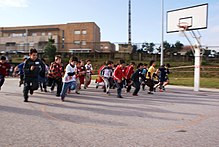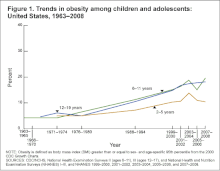Exercise as it relates to Disease/A school-based intervention: Physical Education...is it physical enough?
This Wikibooks page is an analysis and factsheet of “A school-based intervention can reduce body fat and blood pressure in young adolescents.” published in the Journal of Adolescent Health in 2002.
What Is The Background To This Research?
[edit | edit source]High blood pressure and obesity are known risk factors for cardiovascular disease.[1][2] Exposure to these risk factors in childhood and adolescents may contribute to the development of hypertension, diabetes and atherosclerosis later in life.[3][4] Exercise and physical activity are means by which body fat, blood pressure and sedentary behaviour can be reduced and efforts to control these should start during early childhood.[5]
This study aimed to increase the aerobic component of a school’s physical activity program, educate about weight control and blood pressure and evaluate the effect of these interventions on blood pressure and body fat of early adolescent youth.

Where Is The Research From?
[edit | edit source]The sample consisted of students from five middle schools, geographically separated within the state of North Carolina, U.S.A. The authors of this research Robert G. McMurray and Joanne S. Harrell have previously explored the effects of childhood obesity on blood pressure,[6] the influence of rural settings on cardiovascular disease risk factors[7] and the effects of school-based interventions on these risk factors.[8]
What Kind Of Research Was This?
[edit | edit source]This research utilised an individually randomised 2 × 2 factorial design, with three treatment groups and a control group. An analysis of covariance (ANCOVA) was calculated to account for variances in baseline measurements, race, gender and social economic status. A p-value was then calculated to indicate the statistical significance of the research findings.
What Did The Research Involve?
[edit | edit source]The authors selected five middle schools to partake in an 8-week intervention program. The 1140 participants were:
- Between the ages of 11-14 years
- 64% White, 24.4% African-American and 11.6% "Other"
- Had no chronic illnesses or limitations to exercise
The participants were randomly assigned to one of four groups within their school, each adhering to a different type of intervention over the 8-week period:
- Education Only Group
- This group was provided with a knowledge program, presented in class two times a week
- Exercise Only Group
- This group was prescribed a 30-minute aerobic training program, completed three times a week.
- Exercise and Education Group
- This group was prescribed both of the above intervention protocols
- Control Group
- No intervention (however, all four groups participated in their normal PE program, focused on skill development)
What Were The Basic Results?
[edit | edit source]Table 1: Changes in Primary Outcome Variables in Intervention and Control Groups
[edit | edit source]| Education Only | Exercise Only | Education + Exercise | Control Group | ANCOVA p-value | |
|---|---|---|---|---|---|
| Weight (kg) | +1.45 | +1.37 | +1.49 | +1.02 | N/A |
| BMI (kg/m2) | +0.26 | +0.21 | +0.23 | +0.23 | .7090 |
| ∑Skinfolds (mm) | +1.9 | +1.4 | +0.9 | +3.7*** | .0001 |
| BPsys (mmHg) | -1.1 | -2.8 | -2.0 | +1.8*** | .0001 |
| BPdia (mmHg) | +0.1 | -4.8* | -0.5 | +1.4 | .0001 |
| VO2 max (mL/kg/min) | -1.1 | -0.5 | +0.8** | -0.3 | .0001 |
*p = .0001, Exercise Only group vs. Education Only and Control groups;**p = .0001, Education & Exercise combined vs. Education Only group;***p = <.001, control versus each of the other three groups
The data from this research showed that physical activity (PA) can have an effect on blood pressure (BP) in adolescents, independent of weight and fat mass. This is specifically displayed in the results of the Exercise Only intervention group. Their BP decreased by -2.8mmHG (±0.5) systolic blood pressure and -4.8mmHG (±0.6) diastolic blood pressure, despite an increase in weight and BMI (see Table 1). Though the two latter variables increased, the groups ∑Skinfolds result suggest this may be attributed to an increase in Lean Muscle Mass. In contrast, the ∑Skinfolds measurement of the Control Group appeared to rise due to an increase in Fat Mass. A previous study conducted by the same authors, showed no significant association between physical activity and blood pressure. The results of the research this time around, are consistent with others that have discovered a significant correlation between the BP and PA.[9][10] Combining Exercise + Education produced a greater increase in VO2 max (mL/kg/min) than intervening with Education Only and education as a solo intervention did not have a substantial impact BP or BW.
What Conclusions Can We Take From This Research?
[edit | edit source]Though the content and delivery of the exercise intervention was strong, it was not without shortcomings. This study only explored one type of exercise (aerobic) as an intervention. Perhaps other types of exercise could be included for comparison, such as the addition of a resistance training group. There may be more effective means of delivering aerobic training (eg. interval training) or perhaps a greater focus on anaerobic activities may yield different results.
The use of BMI as an outcome variable in this research is questionable, as BMI is a measure for indicating the nutritional status of adults. Since this research was published (2002) the World Health Organisation has developed BMI-for-age (2007), acknowledging that existing growth references assessing obesity in children and adolescents (5-19 years) were flawed.[11] Should similar research be conducted in the future, this new method for calculating BMI would increase the reliability and accuracy of this outcome measure.
The authors suggest that perhaps an increase in duration and exercise intensity would result in greater adaptations to exercise. Other studies have shown that an increase in exercise intensity can subsequently result in a decrease in compliance.[12] This is not surprising, given the importance placed on fun, skill development and social interaction by youth who participate in physical activities such as sport.[13]
Practical Advice
[edit | edit source]
Alarming increases in obesity amongst this population group highlight the importance of early intervention.[14] Physical Education classes offer a regular, scheduled opportunity for school children to develop a positive relationship with exercise. Children should be highly encouraged to participate in these classes by their parents/guardians, as well as schools ensuring their programs are strong, engaging and entertaining.
Encouraging a positive relationship to exercise in a controlled environment may equip children with the skills to participate in and promote physical activity outside of the school yard. Programs that focus on skill development, efficient movement patterns and promote physical activity are a great alternative for children that find sport unappealing. You can find some examples relevant to Australian children and adolescents in Further Information/Resources below.
Further Information/Resources.
[edit | edit source]Exercise programs for Australian children and adolescents:
- Go4Fun is a FREE 10 week healthy lifestyle program for NSW kids aged 7-13 who are above a healthy weight
- BORN TO MOVE™ is a series of programs fostering and cementing positive physical habits in young people from toddler age through to teens (licensed at various facilities throughout Australia)
- GeckoSports instruct fun fitness and multi-sports classes for kids aged 5-13 years old
- YMCA's Teen Gym program is designed for those aged 11-15, developing positive exercise and health habits
References.
[edit | edit source]- ↑ Stamler J, Stamler R, Neaton JD. Blood pressure, systolic and diastolic, and cardiovascular risks: US population data. Archives of internal medicine. 1993 Mar 8;153(5):598-615.
- ↑ Dietz WH. Health consequences of obesity in youth: childhood predictors of adult disease. Pediatrics. 1998 Mar 1;101(Supplement 2):518-25.
- ↑ Goran MI, Ball GD, Cruz ML. Obesity and risk of type 2 diabetes and cardiovascular disease in children and adolescents. The Journal of Clinical Endocrinology & Metabolism. 2003 Apr 1;88(4):1417-27.
- ↑ Raitakari OT, Juonala M, Kähönen M, Taittonen L, Laitinen T, Mäki-Torkko N, Järvisalo MJ, Uhari M, Jokinen E, Rönnemaa T, Åkerblom HK. Cardiovascular risk factors in childhood and carotid artery intima-media thickness in adulthood: the Cardiovascular Risk in Young Finns Study. Jama. 2003 Nov 5;290(17):2277-83.
- ↑ a b Mcmurray RG, Harrell JS, Bangdiwala SI, Bradley CB, Deng S, Levine A. A school-based intervention can reduce body fat and blood pressure in young adolescents. Journal of Adolescent Health. 2002 Aug 31;31(2):125-32.
- ↑ McMurray RG, Harrell JS, Levine AA, Gansky SA. Childhood obesity elevates blood pressure and total cholesterol independent of physical activity. International journal of obesity. 1995 Dec 1;19:881-6.
- ↑ McMurray RG, Harrell JS, Bangdiwala SI, Deng S. Cardiovascular disease risk factors and obesity of rural and urban elementary school children. The Journal of Rural Health. 1999 Sep 1;15(4):365-74.
- ↑ Harrell JS, Gansky SA, McMurray RG, Bangdiwala SI, Frauman AC, Bradley CB. School-based interventions improve heart health in children with multiple cardiovascular disease risk factors. Pediatrics. 1998 Aug 1;102(2):371-80.
- ↑ Ewart CK, Young DR, Hagberg JM. Effects of school-based aerobic exercise on blood pressure in adolescent girls at risk for hypertension. American Journal of Public Health. 1998 Jun;88(6):949-51.
- ↑ Fisher AG, Brown M. The effects of diet and exercise on selected coronary risk factors in children. Medicine & Science in Sports & Exercise. 1982 Jan 1;14(2):171.
- ↑ Onis MD, Onyango AW, Borghi E, Siyam A, Nishida C, Siekmann J. Development of a WHO growth reference for school-aged children and adolescents. Bulletin of the World health Organization. 2007 Sep;85(9):660-7.
- ↑ Eriksson BO, Koch G. Effect of Physical Training on Hemodynamic Response during Submaximal and Maximal Exercise in 11–13‐Year Old Boys. Acta Physiologica. 1973 Jan 1;87(1):27-39.
- ↑ Wankel LM, Kreisel PS. Factors underlying enjoyment of youth sports: Sport and age group comparisons. Journal of sport psychology. 1985 Mar;7(1):51-64.
- ↑ Troiano RP, Flegal KM. Overweight children and adolescents: description, epidemiology, and demographics. Pediatrics. 1998 Mar 1;101:497-504.